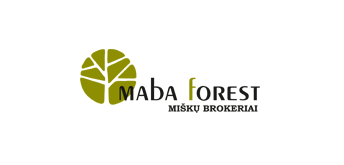Dexter Dombro is the manager of Amazonia Reforestation’s La Pedregoza plantation. He has compiled this article, as an answer to my many questions about investing in Colombian Forestry with his firm. This asset class is of great interest to me not only because it is a real asset, but also as trees are an essential part of the chain of life. Investing in a tree provides much more than financial rewards.
Amazonia Reforestation was founded in 2007 and is a trade name used by Plantación Amazonia el Vita S.A.S. (the “Company”), for the purpose of carrying out afforestation, carbon capture and restoration projects with tropical trees in the Orinoco River basin of Colombia. The plantation is located some 67 KM southwest of the Orinoco River port city of Puerto Carreño, in the Colombian departamento (state or province) of Vichada. At 2,650 hectares (6,546 acres), the plantation has sufficient land base to plant using economies of scale. Nevertheless, Amazonia Reforestation is also able to contract other titled lands, in order to plant trees for profit and for local socio-economic development. On the environmental side, the Company has a 1,200 hectare (3,000
Nevertheless, Amazonia Reforestation is also able to contract other titled lands, in order to plant trees for profit and for local socio-economic development. On the environmental side, the Company has a 1,200 hectare (3,000 acre) natural reserve, registered with Colombia´s national parks system, that is operated through a dedicated non-profit NGO, for the express purpose of conserving the flora and fauna of the Orinoco River basin.
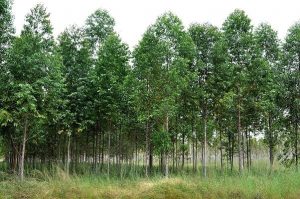
Different types of trees used with Amazonia
The Amazonia Reforestation tropical tree plantation works with over 40 species, of which 6 are introduced commercial species and the rest are native tree species. The commercial introduced species
- Acacia mangium
- Eucalyptus pellita
- A hybrid of Eucalyptus tereticornis
- Gmelina arborea (Melina)
- Pinus caribaea (Caribbean Pine)
On the native tree side, there are cultivations of
- Acosmium nitens (Congrio) (Ironwood)
- Copaifera pubiflora (Aceite)
- Simarouba amara (Simarrú)
- Vochysia lehmanii (Saladillo blanco)
- Saman samanea (Saman)
- Calophyllum lucidum (Cachicamo)
- and others
Planting of each species is done in lots of from 5 to 10 hectares, but with different species in different lots so as to avoid the problems of giant monocultures. The plantation also maintains fruit tree cultivations, primarily with 280 hectares of Anacardium occidentale (Cashews), as well as other hectares with citrus trees (oranges, lemons and mandarins), tamarinds and mangoes.
Since Amazonia Reforestation’s inception, well over 1 million trees have been planted. The objectives with some of the commercial and native tree species are as follows:
Different Tree spieces
| Species | Primary Use | Comment |
| Acacia mangium | Biomass | This tree has a high kilocalorie per kilo count, making it excellent for bioenergy, pellet production and charcoal briquettes or biochar. |
| Eucalyptus pellita | Biomass and Lumber | This tree can be used for pulp and paper, OSB plywood, posts and poles, also dimensioned lumber. It is often marketed as Red Mahogany. |
| Pinus caribaea | Lumber | This tree is very similar to other pine species and can be used for most lumber, general carpentry and construction applications. |
| Acosmium nitens | Lumber | This wood is resistant to termites and rot in direct contact with the soil. As such it is excellent for railway ties, posts, docks etc. |
| Simarouba amara | Fine Carpentry | This tree has insect-resistant wood and is excellent for fine carpentry like furniture, windows, doors etc. |
| Copaifera pubiflora | Fine Carpentry | Another excellent wood tree. This tree can also be tapped for its oil, which is medicinal, or it can be used as a biofuel. |
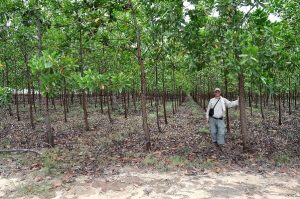
The company has a Managing Director and a Board of Directors. It is a member of Fedemaderas, Colombia´s national federation of wood producers and manufacturers, and of AGAF (Asociación Gremial Agroforestal Vichadense), the regional agroforestry association. Thanks to these affiliations, Amazonia Reforestation has a voice on the National Council for Forestry in the Ministry of Agriculture, as well as in the same ministry’s Regional Cashew Producers Committee. It is presently in a grouped carbon certification program under the Verified Carbon Standard (VCS) and with Icontec, a Latin American standard. The plantation has already completed the base line for FSC (Forestry Stewardship Council) certification with the implementation of a Sustainable Forestry Management Plan, in cooperation with the WWF’s Global Forest and Trade Network (World Wildlife Fund), and anticipates bringing its forestry products to market with FSC origin and chain of custody certifications.
Forestry Investment Cycle
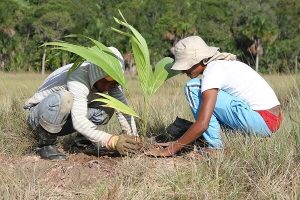
Amazonia Reforestation’s forestry investment products are all based on a maximum 10 year cycle, and offer possibilities for various types of green investors. The forest products can be considered low risk, high return opportunities because trees as a commodity have some interesting qualities. The most obvious one is that there is no pressing need to harvest during bad economic times, unlike other commodities, such as soybeans or corn, which have to be harvested. If the price is low they need to be stored, where problems like storage costs, mould or pests affect the value of the product. In contrast, with wood one can simply leave the tree in the ground, where it will continue to grow until economic conditions improve. Given the Company’s sustainable forestry practices of planting in small lots, maintaining ample fire breaks and cultivating various species, other possible risk factors are further reduced and mitigated. What follows is a table showing the various tree planting products and their buyback values:
Investment products offered
| Purchase Amount | Years until Payout | Description | Annual Growth Percentage | Payout at Maturity |
| $150,000 USD | 8 to 10 | Joint Venture with 10 others, land purchase, lumber trees and cashews, 10% self-insurance | 15% | $450,000 USD plus co-owned land, plus replanting, plus dividends |
| $12,500 USD to $100,000 USD | 8 to 10 | Joint Venture, lumber trees, 100% self-insurance | 7.5% | Better than double original purchase price |
| $4,800 USD in $200 monthly instalments | 10 | Joint Venture, lumber trees, 50% self-insurance | 7.00% | Double original purchase price |
| $100 USD once or in multiples | 10 | Joint Venture, lumber trees, 10% self-insurance | 6.90% | Double original purchase price |
| $2,500 USD | 8 | Joint Venture, 1 hectare of Cashew Trees | 9.00% | $5,000 USD |
| $100 USD in monthly instalments | 10 | Carbon capture and offset account with native trees, 15% self-insurance | N/A | 250 metric tons of CO2 sequestered |
Amazonia Reforestation only uses sustainable practices. The Company avoids the use of agrochemicals, preferring to use natural fertilizers such as composts, compost teas, manure, bokashi and biochar as a nutrient retention agent. The goal is to grow the tropical trees in healthy soils, without contaminating adjacent water ways, wetlands or ground water. Healthy soils in turn mean more pest and disease resistant cultivations. The policy is to use, whenever possible, biological controls and organic insecticides and fungicides, if required. The Company has opted for more labour intensive, less mechanized practices, in order to assist with local socioeconomic development. The idea is to have the community benefit from its forestry operations, by employing local families and individuals, while complying with all labour law and social support requirements.
Returns are not only financial
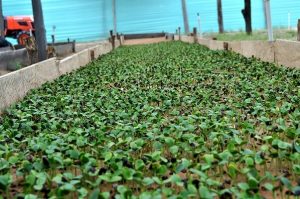
Green investors with Amazonia Reforestation know that their participation as joint venture partners is profitable, but also comes with a number of non-financial returns. Those returns include sustainable forestry practices, carbon capture in the struggle against climate change, the active promotion of biodiversity due to the planting of native tree species, agrochemical contamination free operations, conservation of local ecosystems thanks to the natural reserve, wildlife corridors throughout the plantation, the protection of pollinators such as bees, and the promotion of local socioeconomic development in the region.
Forestry products from Amazonia Reforestation are environmentally friendly, and produced using sustainable practices. This differentiates them from other commercial producers, who rely on intensive agricultural and forestry practices, or who harvest from natural forests, without serious replacement planting. In a similar manner, the Company’s socioeconomic development policies, opting for more labour intensive operations, distinguishes them from heavily mechanized let’s plant and extract competitors.
Risks
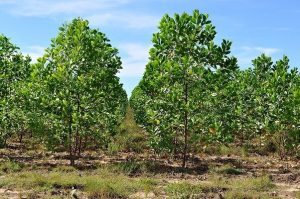
The largest risk factors are forest fires. This is mitigated with the use of smaller lots, each surrounded by ample firebreaks, as well as the on-site maintenance of a local brigade. The Company does controlled counter burns during the critical dry season and maintains water tanks, spray systems and other tools in order to mount a rapid response to any potential danger. Lightning may pose a risk, but is contained thanks to the small lot sizes. Amazonia Reforestation practices self-insurance, planting other trees of different species in different locations or lots, as a strategy for compensating for any potential losses. This self-insurance may be as high as planting one additional tree for every tree for which it has a financial commitment. Force majeure risks are expressly recognized in the joint venture agreement with tree purchasers, such as tornados, floods, drought, war etc.
Our programs are based on the lumber trees needing 10 years to mature, before being harvested and sold. Nevertheless, there is a possibility that trees planted for biomass may reach a satisfactory growth in terms of cubic meters per hectare by the eighth year, in which case harvest and sale may occur earlier than contracted, with a subsequent early distribution to investors. In the case that someone wishes to cash out early, the only thing the Company can do is circulate their offer to existing and new investors, to see if someone is interested.
Amazonia Reforestation is dedicated to plantation forestry. The Company believes that it is a no brainer having one’s coffee table made out of plantation wood and not out of old growth rain forest wood. As such, investors should be cautious about tree investments involving extraction from natural forests, as laws can change at any time and the environmental consequences may also be non-sustainable. Unless one is prepared for a very long wait, such as 30 years for teak, it is best to invest in rapid-growth tree species, where returns can be generated in just 10 years. It also makes sense to look for a fixed buyback price, as opposed to some nebulous future market value. Beware of promises of overly high returns, as they may not be realistic.
For more information, please contact
- COO, Dilmun Dombro, by email to

- Sales and marketing director, Dr. Kochu Rani Dombro,

The administrative offices are located at Cra. 16 A No. 78 – 55, Of. 502, Bogota, D.C., Colombia, while the operational offices are located at Transversal 14 No. 15 – 62, Puerto Carreño, Vichada, Colombia. Telephones: +57-313-731-3057 or +57-1-704-6852 or VoIP +1-780-628-728.
The Company´s website is Myreforestation.com
We thank Dexter B. Dombro for this great article.
As per all the investment ideas on this site, this article does not represent a recommendation or an endorsement. Each investor needs to do his or her due diligence and consult a financial advisor. Make your own due diligence. Please also see my SWOT analysis of agricultural investments.



